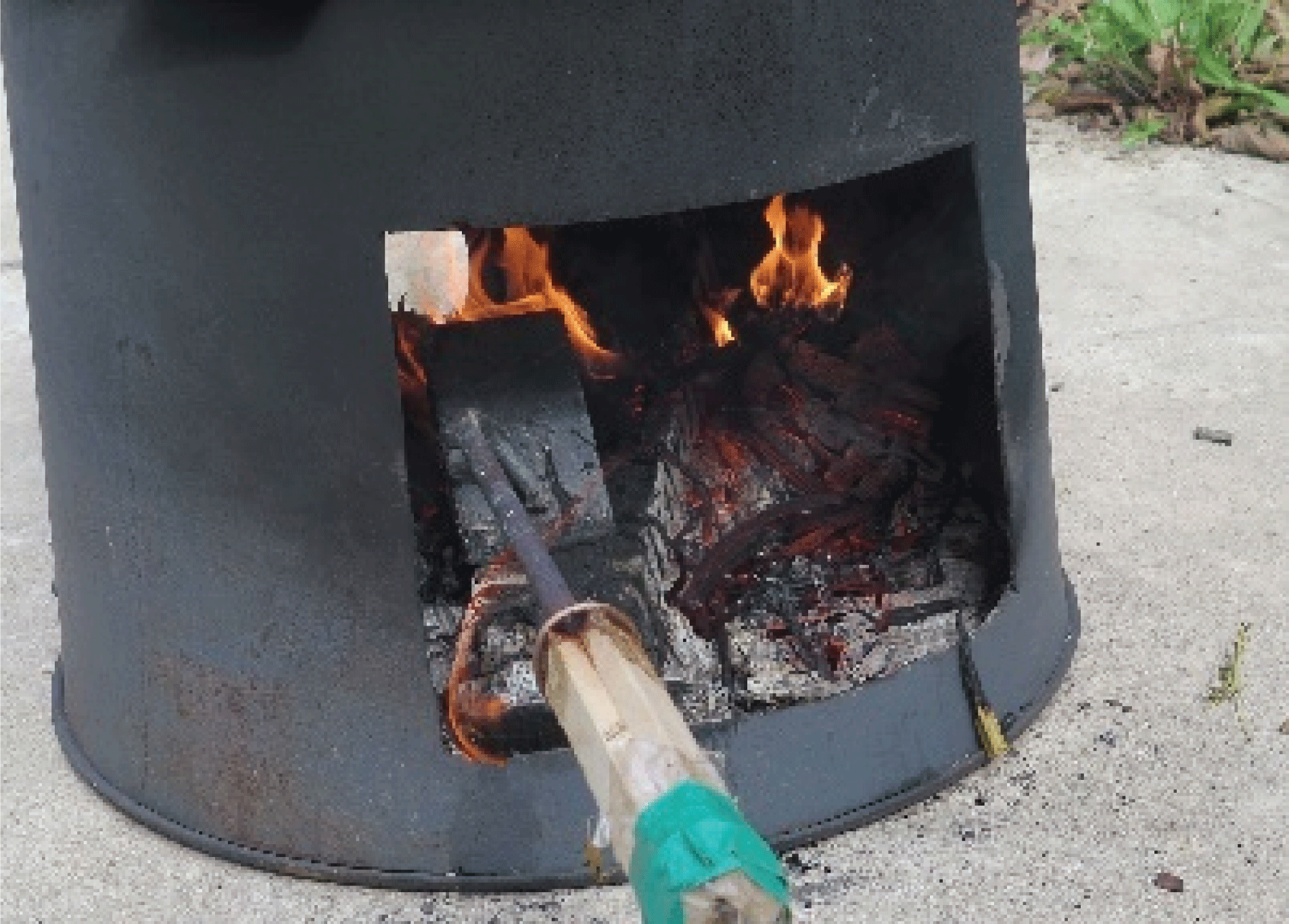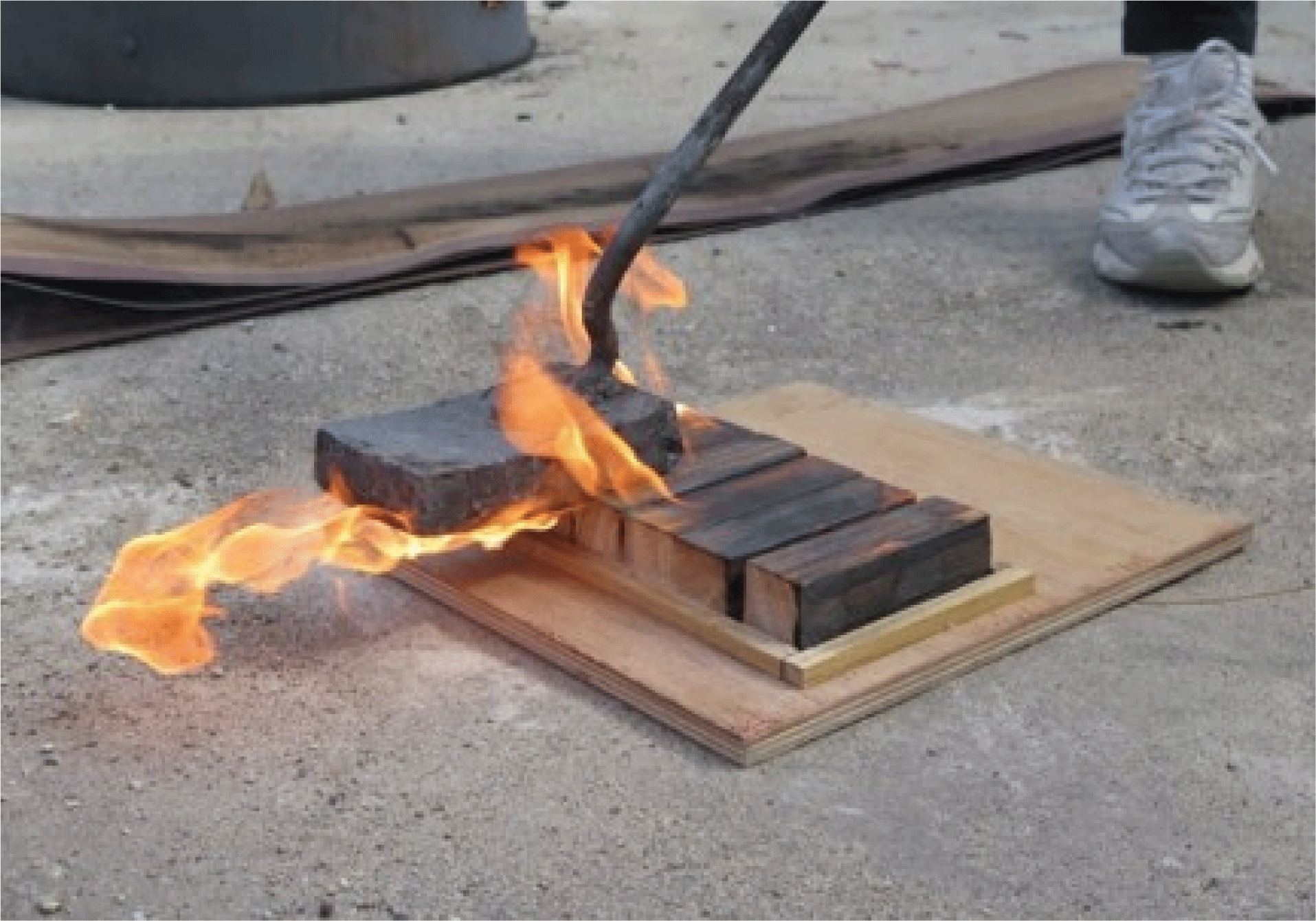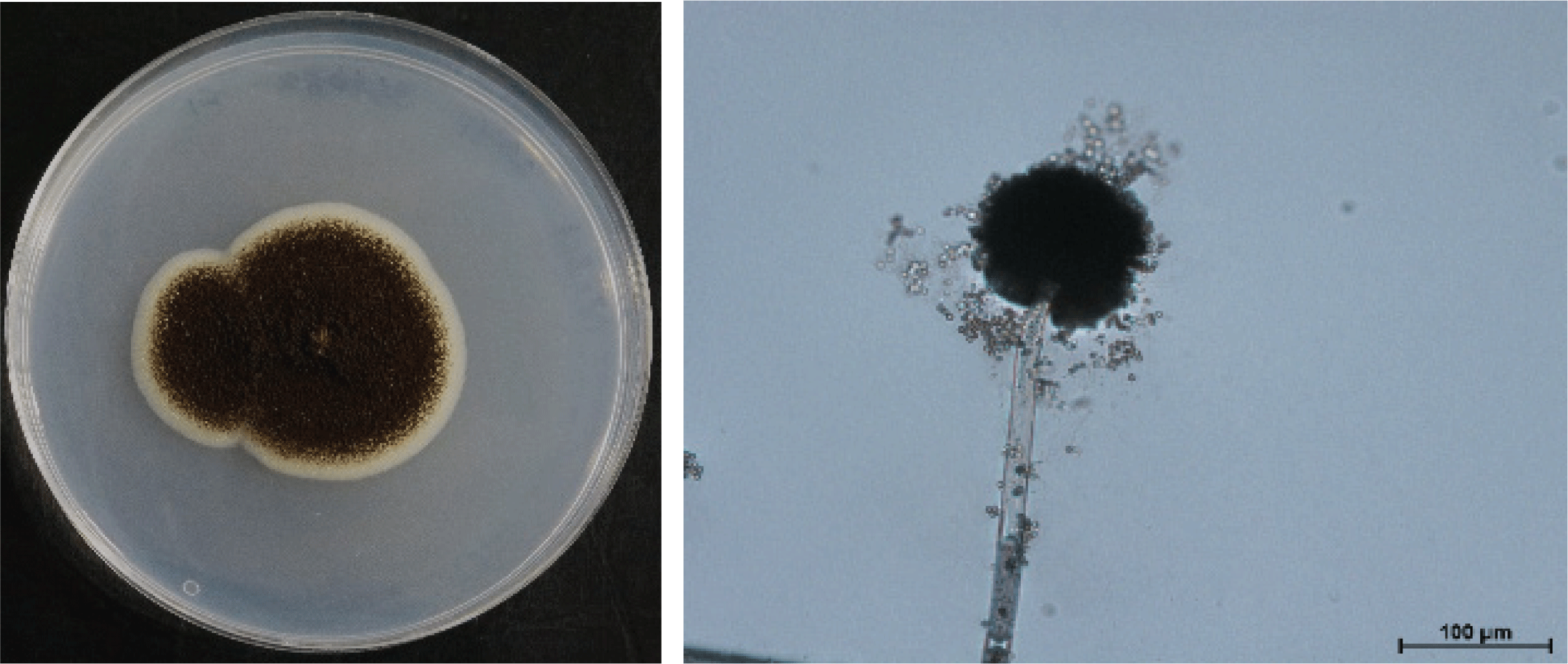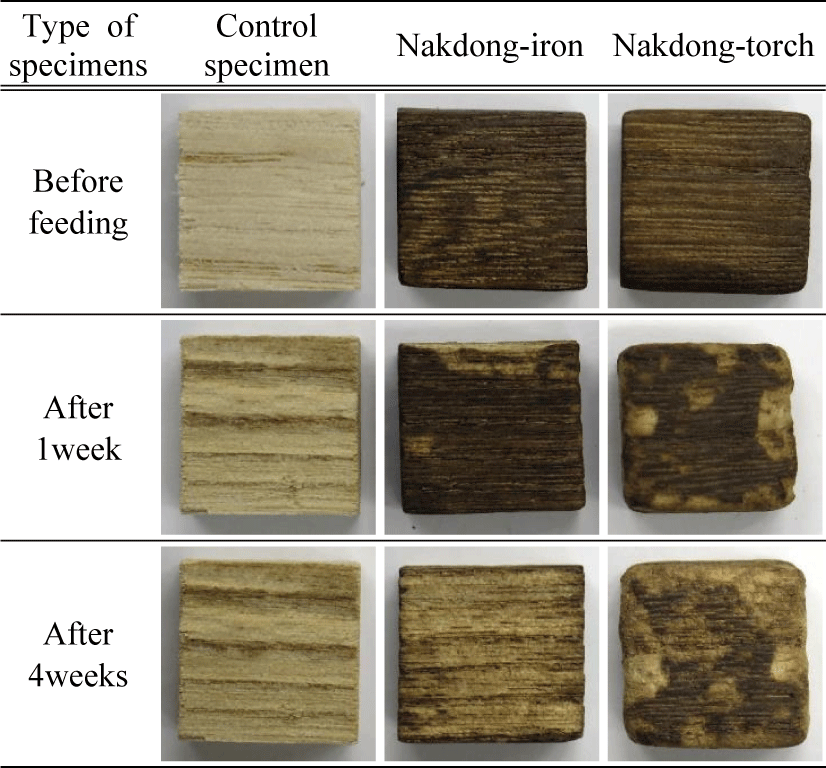1. INTRODUCTION
In the process of making Asian string instruments like Korean geomungo and gayageum, Chinese zheng, and Japanese koto, the surface of paulownia wood is often finished by scorching with a hot iron of over 1000°C. This technique, called Nakdongbub (낙동법: 烙棟法, Nak: 烙, is scorching, Dong: 棟, means paulownia wood, and Bub: 法, stands for technique), renders the surface of the wood dark brown. This technique has a long history: we can find representative evidence on the surface of several objects such as musical instruments, furniture, and even ships (Yoshikawa and Waltham, 2014). As the musical instrument is one of the living-objects of history, this technique is still used as a conventional method to finish the body part of the string instruments’ surface. Although in modern times, some instrument makers modified the traditional Nakdong technique: burning the surface of wood by using a torch itself instead of heated iron, the Nakdong technique is still an indispensable surface treatment technique on some objects.
Musical instrument masters still use the Nakdong technique because it has many beneficial effects referred to in musicology papers as well as in oral tradition. Nakdong’s effects are shown to be beneficial in moderating the effects of changes in temperature and humidity and in combatting bacteria. Storage cabinets treated with this technique on all sides, help to protect their contents by keeping away insects and fungi (Bae, 1988). Newly cut paulownia wood is white and soft, and the color slowly turns dark over time as the wood tissue deteriorates. For aesthetic purposes, the darkening color of the wood surface was covered by the method of scorching and scrubbing the surface (Cho, 2005). The treatment helps to prevent pests and corrosion caused by moisture (Kim, 2010). However, compared to the following advantageous examples written in musicology papers, few scientific studies support a typical technique of Nakdong.
Similar to this treatment, in European countries, a method of thermal treatment is used to remove organic compounds from the wood cells. Thermal treatment is different from Nakdong treatment: thermal treatment uses indirect air-heated method; on the other hand, Nakdong treatment uses direct method. In the thermal treatment, the wood is heated in an oven of over 180°C: treating air-heat on the wood in the form of steam or gas by filling it inside the chamber. This treatment is known to change the chemical structures of cell wall’s components and improves the wood itself physically and chemically, in turn cultivates resistance against decay. Since the thermal treatment study was first conducted in 1920, this process has still been researched and highlighted these days (Cahyono et al., 2020; Candelier et al., 2016; Chang et al., 2019; Hakkou et al., 2006; Kim et al., 2018b; Liu et al., 2016, Park et al., 2020; Priadi et al., 2019).
This study focused on evaluating its notable effects: water resistance, control effects against termite and microorganisms, and sound quality improvement. In order to understand the mechanism of the Nakdong technique and its effects, mock-up samples were reproduced using traditional and modern iron and torch equipment. The surface microorganism collection and the vibrational test were carried out at Gugak center placed at Seocho-gu, Seoul. This center is the only national museum for Korean traditional music and dance. And it has collections of ancient traditional musical instruments, old notation books, and related materials. This study is expected to give a contribution to understanding the authentic advantages of the Nakdong technique, which is still used.
2. MATERIALS and METHODS
As this technique is mainly applied on the surface of the musical instruments’ body part, the wood, which was well dried for more than five years in an external environmental condition, was selected. The wood was cut into the right size, depending on the research method. Its surface was trimmed evenly by hand plane (Table 1). Surface treatment was made on all six sides of the sample on water resistance, anti- mold effect and anti-termite effect test. As for the sound quality, surface treatment was made only on the upper side of the sample. For the experiment, two pieces of equipment, iron, and torch were used. For the iron equipment, 130 cm length pole with about 3kg iron attached on one end. For torch equipment, 6.2 cm diameter head was connected with the LPG gas device. Before treating the iron, it was heated in a hot kiln stove for about 30 minutes, when the heat of the iron reached over 1000°C, it was ready to be used (Fig. 1). At the moment the iron equipment was treated on the surface of the wood, the temperature of the iron fluctuated between 800 and 1000°C. It was pressed along the direction of the wood grain with one stroke taking a couple of seconds (Fig. 2). After one stroke the iron equipment was put on the kiln to make it ready to reuse: the temperature of the iron reached over 1000°C. This process was repeated to treat Nakdong on the wood. The torch sample was directly treated by the torch itself, and the torch temperature was above 1000°C when it was treated on the wood sample for a couple of seconds. While proceeding the procedure, the temperature was measured by an infrared temperature measuring instrument (845, Testo, GER) to get the result as objective as possible. After treating Nakong, the burnt surface was brushed off with a pigtail brush and a sponge. Before and after treating iron and torch equipment, mass, length, and thickness of the sample was measured, and the results was utilized to calculate the subject of the sound quality efficient experiment.
| Research Area | Dimensions (mm) |
|---|---|
| Water resistance | 100 (L)×30 (W)×30 (T) |
| Anti-mold effect test | 50 (L)×20 (W)×3 (T) |
| Anti-termite effect test | 20 (L)×20 (W)×10 (T) |
| Sound quality | 300 (L)×20 (W)×10 (T) |
The contact angle was measured by using a mobile drop surface analyzer (GH11, KRUSS, GER) to examine the spread ability of water drops. A curvature of water droplet angle and lengths of the absorbance time were measured.
Water absorption test was conducted by the sample 30 (width) × 100 (length) mm that is treated with an iron and a torch. Each treated sample was immersed in distilled water for 24 hours. The corresponding weights of the samples, before and after water absorption, were measured (Explorer, Ohaus, USA). The amount of water absorptivity (WA) and reduction in water absorptivity (RWA) was calculated as Eq. (1) and (2). In order to see the significant differences between control group and each iron and torch treated samples, a statistical analysis (t-test) was applied to the value of WA.
W0=Weight of specimen before immersion (g),
W1=Weight of specimen after immersion (g)
WA1=Treated wood weight (g),
WA0=Untreated wood weight (g)
Surface fungi from the Nakdong technique treated musical instruments were collected from the Gugak Center's 1st, 2nd, temporary and underground storage. The surface microorganisms of gayageum, geomungo, and agaeng were collected with sterile cotton swabs and streaked on PDA medium (Potato Dextrose Agar, Diffco, USA), incubating on 26±2°C, 60±5%, for 3 to 5 days. The grown microorganisms were pure-cultured according to the size, shape, and color of the colony. Under the same conditions, fungi were incubated on PDA medium and bacteria on the NA medium (Nutrient Agar, Diffco, USA) for 3 to 5 days.
Among the collected microorganisms, wood-degrading enzyme activity evaluation was conducted. It is an assessment to verify the degradation degree on the wooden substrate such as cellulose, hemicellulose, lignin fibers, and starch. Purely separated microorganisms were inoculated in the middle of the selective medium (CMC-PDA·NA, Xylan-PDA·NA, Lignin-Agar, and Starch-PDA·NA) and cultured in an incubator for 5 to 10 days. Incubated microorganisms in CMC and Xylan medium were dyed with 0.1% of the Congo-red and left for 30 minutes in the darkroom state. And then, it was decolorized for 15 minutes by applying 1.0 M sodium chloride solution. On the starch medium, the potassium iodide solution was used. For the Lignin medium, clear-zone could be identified as the microorganism was incubated.
Through visual inspection by measuring clear-zone, the decomposers were divided into no active (0 mm, -), weak active (1-5 mm, +), good active (6-10 mm, ++), and strong active (11-15 mm, +++), which were converted to 0, 1, 2 and 3 points respectively for grading. Based on the calculated values, the final risk rating was assessed as grade 5 (0-20%), grade 4 (21-40%), grade 3 (41-60%), grade 2 (61-80%), and grade 1 (81-100%). Among them, one strain with the highest final risk rating was selected as test fungus. Selected test fungus species were identified by the slide culture method.
In accordance with Standard No.2 of the Japan Wood Preservation Association (JWPA, No.2), on 90 mm, and 15 mm-sized petri-dish, 1.5% of agar was solidified. Plastic net, torch, and iron technique treated wood samples were put in order, and then strain suspension was treated. The test was repeated nine times, incubating at 26±2°C, 60±5% for four weeks. After incubation, the growth level state of the fungus was classified into four stages from 0 to 3, and the mean value was calculated (Lee et al., 2018).
Some researches describe the effects of insect resistance of the Nakdong treated surface (Bae, 1988; Kim, 2010). But it didn’t mention what kind of insect species are resistant. This experiment was decided to proceed by using insect termite because the Nakdong technique is treated on the surface of the paulownia wood, and a termite is a pest for old wooden musical instruments and cultural artifacts. The experimental procedure design was adapted from SNI 01.7202-2006 and JIS K1571-2010 with minor modifications. The musical instrument is mostly stored on a conditioned storage system, so the experiment specifically focused on the environment: without soil and percentage of soldier termites in the containers were controlled not to exceed 10 percent. Subterranean termites, Reticulitermes speratus were collected at the mountain near the Korean National University of Culture Heritage. Breeding containers were prepared by blocking one side of an 80 (diameter) × 60 (height) × 50 (thickness) mm sized cylindrical acrylic with dental plaster. The bottom of the container was set with damp cotton to control the condition, and the experiment condition was maintained at 28°C, >80%. The iron and torch treated and untreated samples were placed in the center of the container, and two hundred active worker termites and three soldier termites were introduced into each container and put in a darkroom state for four weeks. All termites were counted every-week to measure the population of termites, and the percent of mass loss, termite mortality, and feeding rate of each termite was calculated based on following Eq. (3), (4), (5). Initial and final oven-dry weights of the samples were measured after cleaning off the debris from the termite attack (Hadi et al., 2014). Also, photography was taken every week to observe the eating patterns of termites. Microscope observations were conducted to identify more accurate eating patterns.
W1=weight of oven-dried wood specimen before feeding test(g),
W2=weight of oven-dried wood specimen after feeding test(g)
Sample measurement was performed after three months of stabilization in the controlled condition of 20°C and relative humidity 60% until it stabilized to the equilibrium moisture content of 12% (TH-ME-100, Jeiotech, KOR). And then, weight, length, and thickness were measured to achieve the density. The sound quality measurement was tested by modal analysis; the specimen was held on non-contact forced vibrations free-free bars, and the acceleration sensor was attached underneath part of the specimen center. By using the impact hammer, one edge of the upper part was hammered, and resonance frequency was measured. Every twenty specimens were hammered three times, and the average of the frequency response function value was obtained. After achieving the frequency (Hz), dynamic Young’s modulus (E, Gpa), sound velocity (c, m/s), and sound radiation coefficient of the wooden bar were determined by Eq. (6), (7), and (8).
ρ: density, L: length of sample, f: frequency rate,
m: 4.3730, h: Thickness of the sample
3. RESULTS and DISCUSSION
By measuring the contact angle after three minutes, all the reproduced samples were hydrophilic as the angle showed <90° (Fig. 3). The control sample had absolute wetting, while Nakdong-iron and torch treated samples showed gradual absorbance. When water drop was put on the surface, at first, control and iron treated samples seemed to be wetting fast, but the iron treated surface kept an oval shape water drop for nearly 20 minutes. The total surface water drop absorbing time was 28'57", which seems like something was blocking the surface layer (Table 2).

| Type of specimens | Control specimen | Nakdong iron | Nakdong torch |
|---|---|---|---|
|
|
|||
| Subjects | |||
| Average absorption time of the droplet | 4'14" | 28'57" | 8'40" |
After the water absorption test, low moisture absorption was measured in the order of Nakdong- iron, torch, and control samples. WA of all the samples settled at the 30's (Table 3). The RWA of the iron treated surface was 14% and torch treated ones were 4%. By t-test analysis between control and iron treated samples p-value showed 0.029. As the value is lower than 0.05, there is a statistically significant difference between control and Nakdong-iron samples’ water absorptivity. But between control and torch treated samples, water absorptivity, p-value appeared as 0.475, as presenting that there is no statistically significant difference. Overall, and by RWA result, there is more water resistance shown on the iron treated surface than the torch treated surface.
| Type of specimens | Control specimen | Nakdong iron | Nakdong torch |
|---|---|---|---|
|
|
|||
| Subjects | |||
| Average of WA (%) | 36.43 (3.86) | 30.82 (2.73) | 34.46 (4.40) |
| Average of RWA (%) | - | 14.10 (1.25) | 4.32 (1.49) |
Ten types of fungi and seven types of bacteria were isolated from the surface of musical instruments finished by the Nakdong technique. Four types of fungi were collected from geomungo, seven types of fungi collected from gayageum, and two types of fungi and seven types of bacteria were found from agaeng (Table 4).
The activity of the substrate decomposition enzyme was evaluated with the collected microorganisms. In general, the risk rating of bacteria was grade 3, which indicates high resolution (Table 5). Among fungi, F1 had a high lignin resolution, and F5 showed a high resolution in cellulose and hemicellulose. The results of the risk rating calculation showed that F5 had the highest resolution among the fungi with grade 3, so it was selected as a test fungus.
By the microscope observation of the selected fungus, F5 showed black-colored, and spore spreads. At the end of the mycelium, bulkheads were observed, and the shape of the head was spherical, which is identified as Aspergillus species (Fig. 4).
By the observation of the anti-mold efficacy test for four-weeks, fungi spores appeared clearly from the third week. The control and the iron treated group showed 1.6, and the torch treated group showed 1.3. After four weeks, on the side of the wooden sample of the control and iron treated group, the spore of fungi was observed and valued at 2.0 (Table 6). As the evaluation values of each week appeared in a different growth rate, it showed a different growth rate of microorganisms, but by the resulting of the final-week, the effectiveness of the microbes seemed to be low. This was also shown in the study of the anti-mold characteristics. Although A. niger, A. Pullulans, P. citrinum, and R. nigricans test in the PDA medium were found to be effective for anti-mold by showing restriction on fungi growth, they were not effective in the wood (Lee, 2004). As a result, Aspergillus species used as a test fungus had high growth capacity in wood.
| Period | After 1 week | After 2 weeks | After 3 weeks | After 4 weeks |
|---|---|---|---|---|
| Type of specimens | ||||
| Control specimen | 0.2 | 1.0 | 1.6 | 2.0 |
| Nakdong-iron | 0.1 | 1.0 | 1.6 | 2.0 |
| Nakdong-torch | 0.3 | 1.2 | 1.3 | 2.0 |
When the termites intake food, the eating patterns showed from a week later: the control group ate along the wood grain. In the iron treated specimen, generally, intake marks were identified, while in the torch treated specimen, irregular intake patterns were observed (Table 7). This is attributed to the fact that paulownia wood, which has as high cellulose content as hardwood, has higher lignin content (Timothy and Cammi, 2009; Lee et al., 2014; Shelton and Grace, 2003). So the termites, which have a habit of eating cellulose as their primary food source, ate wood except for lignin.
The mass loss of the control and iron treated surface was about 4.5%, while the torch treated surface was 7.35% (Table 8). Similarly, there was a resistance study by termites against the oven treated paulownia wood, the mass loss was lower than the control group, and as the temperature of oven treated sample increased, the mass loss increased (Kim, 2018a). On the termite mortality, the iron treated surface showed about 10% higher mortality than the control and torch treated samples. The wood consumption was lowered in the order of torch treated, control group and iron treated samples.
After the different treating methods on the surface of the paulownia wood and by comparing its physical acoustic property, density changed on both treating method. The dynamic Young’s Modulus increased after treated with Nakong-iron; on the other hand, it decreased after treated with Nakdong-torch. For this reason, the speed velocity increased on the Nakdong-iron treated surface, as the Nakdong-torch treated ones decreased (Table 9). As comparing the sound radiation coefficient before and after Nakdong treatment, the average value of the Nakdong-iron has increased by nearly 1.2 m4/kg s while Nakdong-torch has increased 0.13 m4/kg s (Fig. 5). This means that by using the Nakdong-iron technique, the vibration of the musical instrument would increase much better than Nakdongtorch treating. Similarly, there were studies about thermally modified wood, and it showed how the method contributes to use it as musical instrument material (Pfriem, 2015). Also, due to the thermal modification of the soundboard wood of the guitar, the quality of vibration increased in the objectively measurable parameters, which verified that the thermal treatment improves sound (Wagenführ et al., 2005). On the heat treatment of the gas permeability study on Paulownia tomentosa wood, by 100°C, 160°C and 200°C treatments, the gas permeability and sound absorption coefficient of heat-treated samples slightly increased depending on the heat treatment temperature (Kang et al., 2019).
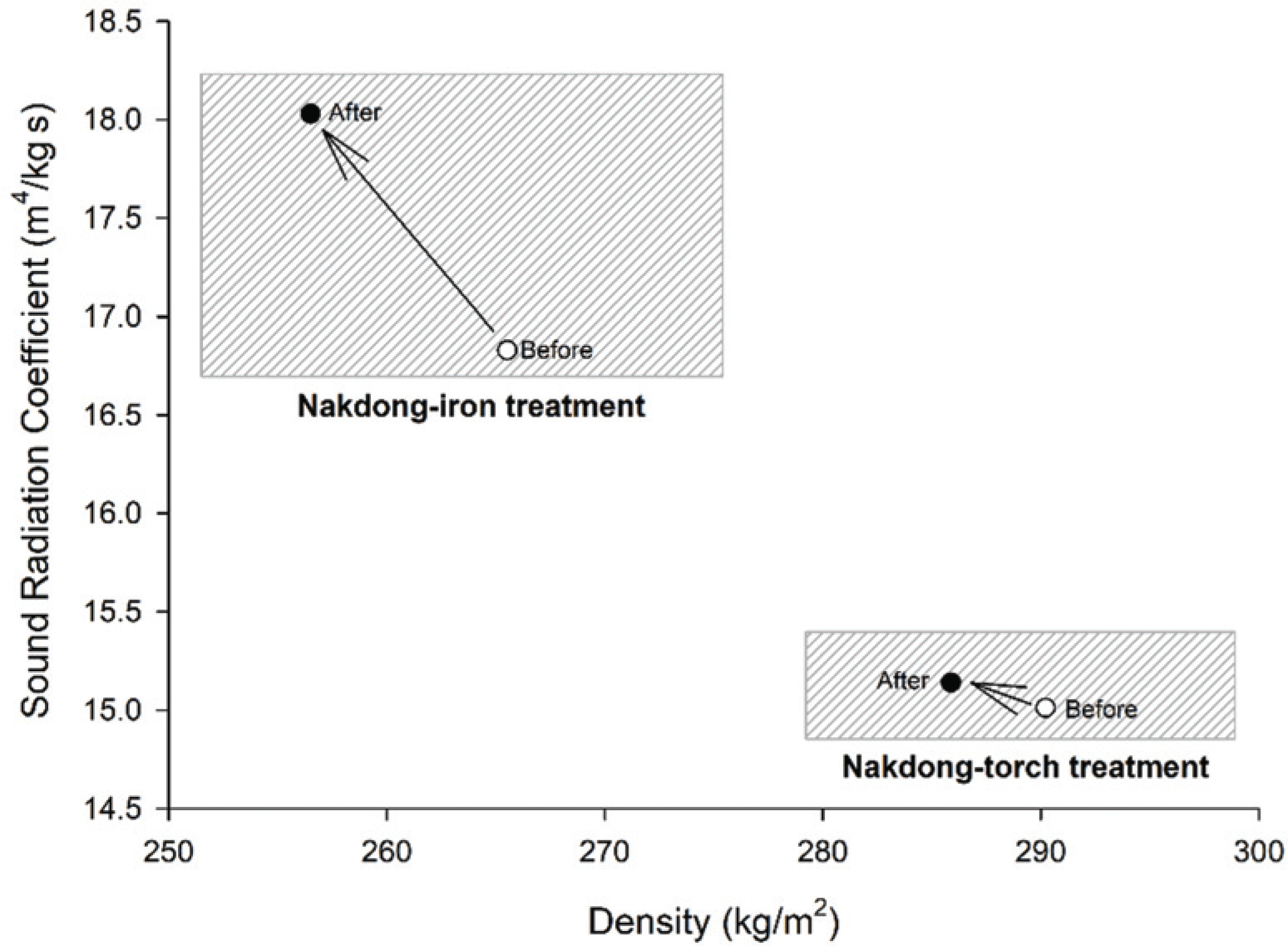
4. CONCLUSION
Nakdong-iron and torch techniques are used in modern times on the surface of paulownia wood to make the main soundboard of the musical instruments. This treatment was reproduced in this study, and the effectiveness of the Nakdong technique was identified by carrying out a water resistance, anti-mold, anti-termite test, and by examining physical sound properties. Comparing the value of the results, it appeared that the traditional Nakdong method of using an iron showed more efficient than using a torch in terms of functional benefits such as water resistance and sound quality improvement, but it appeared that it does not have an anti-mold effect and anti-termite. But for the anti-mold efficacy test, only one fungus, Aspergillus species, was used for the experiment. For further future study, anti-mold effect tests with more diverse fungi species and preservative effect tests could be suggested. In the anti-termite experiment, some results of mass loss, termite mortality, and wood consumption showed a distinct difference between each group in this study. But compared with other research values related to thermal treatment methods, the value in this study showed an insignificant change because the experiment design was not the same condition as other researches (Ariana et al., 2012; Candelier et al., 2020; Kim, 2018a; Yusuf et al., 2014) Nakdong treated sample showed more water resistance than the torch treated surface. On the CA experiment, the length of water droplet absorbing time was nearly 30 min in Nakdong-iron treated surface. It can be assumed that the heat and pressure procedure changed the shape of the wood cell for the Nakdong-iron effect. Therefore, as long as the scorched paulownia wood is not stored in a damp environment for a long time, the musical instrument with Nakdong-iron treated surface will be better managed in a humid condition than Nakdongtorch treated one.
Despite the efforts to prove the functional efficiency of the Nakdong technique, more research is needed to develop new experiments that will deal with the various Nakdong treated musical instruments and strengthen the documentation of the Nakdong technique.









